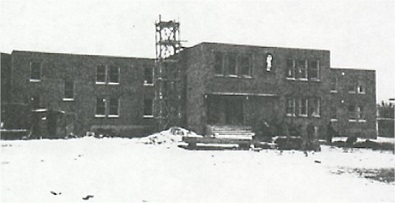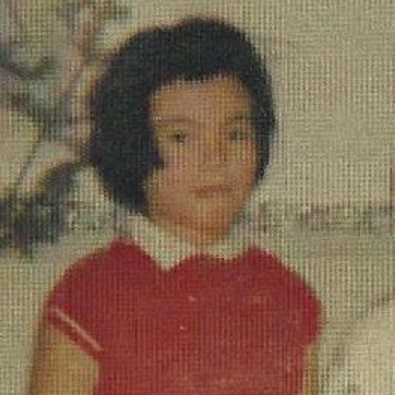The old girls’ dorm and hospital in Ile-a-la-Crosse. Photo courtesy jkcc.com
This is the second story in the two-part Ripple Effect series, the first can be accessed here and an audio report on this story can be heard here.
A number of former Ile-a-la-Crosse students who witnessed a girl drown in 1968 say they still struggle today with the effect of nuns and priests at the boarding school who forced them to suppress their childhood emotions.
The 13-year-old drowning victim Linda Aubichon is remembered as a friend, classmate, or a family member. She was a mother figure to her niece Mary Aubichon and “a playmate or a sister” to Martha Aubichon, a “best friend” to Terrie Bekkatla-Dongu. Delia Alberg calls her “an awesome person to know.”
Those women’s fond memories of Linda remained unspoken at her funeral in Patuanak, because leadership at their Roman Catholic-run boarding school did not allow kids at school to attend the fly-in service.
Had there been a supplemental ceremony in Ile-a-la-Crosse to mourn Linda’s June 1, 1968 death, “it would have been much easier to deal with,” Alberg said, adding that Linda had been among the few people she relied on after living away from family for so long.
As the school year came to a close, the girls shed their tears under their bedsheets at night.
“I can’t go to a nun and say ‘hey this is how I’m feeling, this is where I’m hurt.’ I can’t say that,” Martha said. “If they found out that we were crying or whatever, we’d get punished for that.”
Beyond being unable to talk about losing a friend, Alberg said the traumatic nature of Linda’s death was “not talked about. There was no counselling for it and being in the convent you didn’t just sit around there and talk about it either or cry on each other’s shoulders. It wasn’t like that. You just had to move on, move on. And you live with this day, in day out, knowing what you’ve seen, and a loss of life. So it’s pretty devastating.”
Bekkatla-Dongu, who swam out to try to save Linda but got pulled down in the process and was forced to watch helplessly as Linda’s life ended, was tormented by how quickly the girls were expected to move on.
“She was just taken away like she didn’t mean anything,” Bekkatla-Dongu said, her voice thick with emotion. She recalls the military-like presence of the nuns, who she said provided no comfort.
Linda Aubichon pictured the Christmas before her death. Photo submitted by Mary Aubichon.
Mary remembers how deep the suffering went for years after Linda drowned.
“You kind of have to keep your emotions and your feelings in. So you learn how to do that to suppress our feelings. And we don’t know, we go through life numb in that emotion. Yet in the back the memory is still there, it’s still in the back. And maybe the inner child wants to cry about it,” she said.
This wasn’t the only death suffered during Ile-a-la-Crosse boarding school’s long run. Other stories from the school’s survivors were shared at a Sept. 2016 gathering in Ile-a-la-Crosse, where Indigenous and Northern Affair Minister Carolyn Bennett was present.
Martha recalls being trained to conceal her feelings while in school: “my emotions, my feelings, are gone. I know how to hide it. We were carved into that.” This process was true of Indian Residential Schools across Canada, as chronicled in Truth and Reconciliation Commission’s final reports.
But while students at the so-called Metis school (which also housed Cree and Dene children) suffered the same treatment, the fact that their school was run by the Roman Catholic church and not the government has kept them separate from the Indian Residential School settlement process.
Now, Martha said there is a ripple effect in her life.
“To tell you the truth I hide a lot of my emotions. Right now, me talking about her (Linda), I’m trying to swallow a lump here. I’m trying to clear my voice.”
However, she said that cycle has been broken in her children and grandchildren, who are very expressive.
Alberg, who now lives in Saskatoon, said without the closure of a funeral for Linda, she was affected into her teen years.
“It’s something later on in life that I got some counselling for and I addressed a lot of what had happened then to be able to process my own stuff,” she said. “That was the only way I was able to let go.”
Mary said she has recovered from her time at the school through the simple act of allowing herself to cry and going through “self therapy:” a process that didn’t start until her brother’s death in 2012.
“It took a while for me to understand that it’s okay to talk about your loved ones. It’s okay to talk about it even though people say let them rest, they are resting. It’s us that are not resting,” she said.
“We will remember the good things instead of what hurts us. That’s what healing is to me.”
For Bekattla-Dongu, the interview process for the Ripple Effect series has provided at least a small bit of closure.
“There’s something missing. There’s something not there, that until I see something, or do something or something happens about this matter that I will fully put it to rest. I feel like it’s unfinished because nobody talked about it,” she said.

